2007 ISUZU KB P190 low oil pressure
[x] Cancel search: low oil pressurePage 3974 of 6020
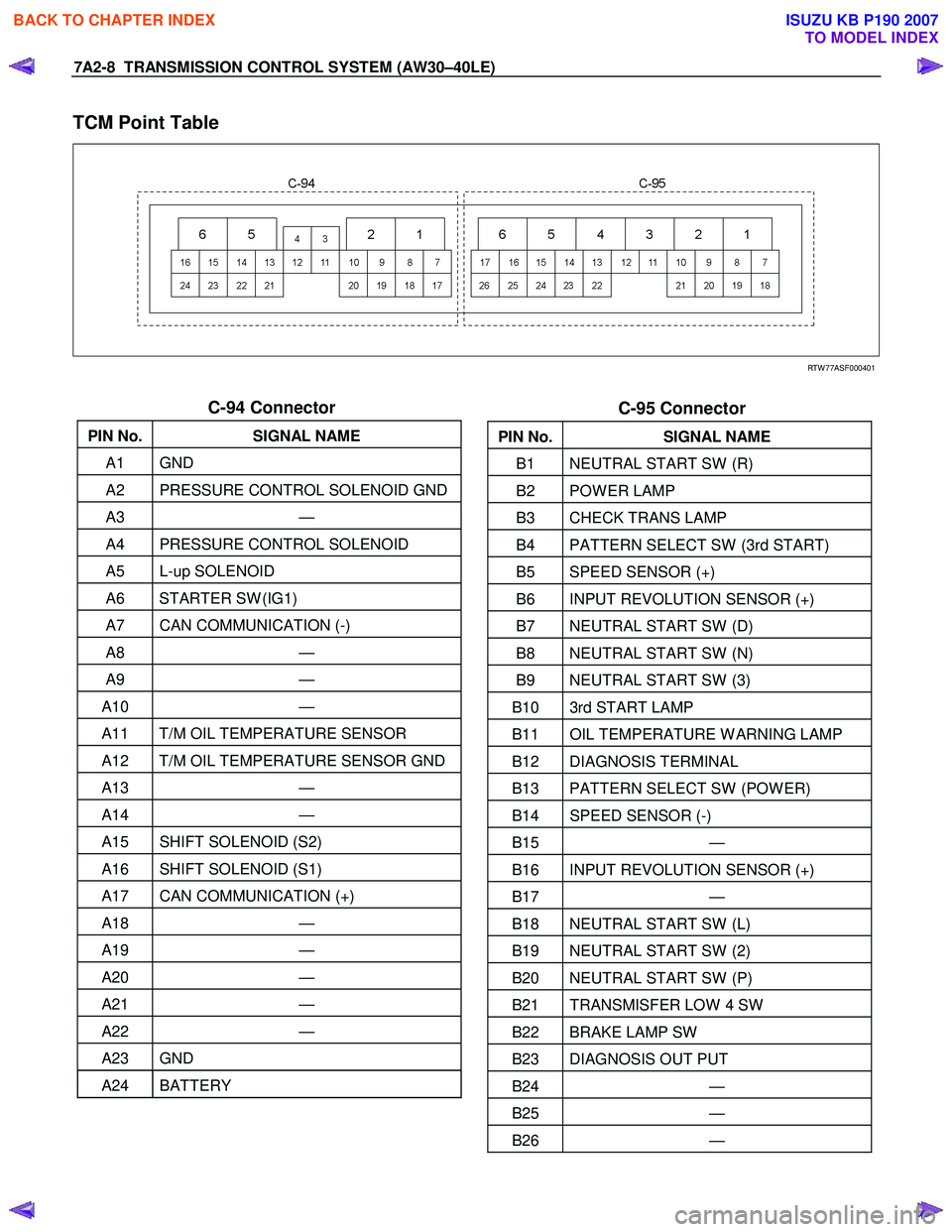
7A2-8 TRANSMISSION CONTROL SYSTEM (AW30–40LE)
TCM Point Table
RTW 77ASF000401
C-94 Connector
PIN No. SIGNAL NAME
A1 GND
A2 PRESSURE CONTROL SOLENOID GND
A3 —
A4 PRESSURE CONTROL SOLENOID
A5 L-up SOLENOID
A6 STARTER SW (IG1)
A7 CAN COMMUNICATION (-)
A8 —
A9 —
A10 —
A11 T/M OIL TEMPERATURE SENSOR
A12 T/M OIL TEMPERATURE SENSOR GND
A13 —
A14 —
A15 SHIFT SOLENOID (S2)
A16 SHIFT SOLENOID (S1)
A17 CAN COMMUNICATION (+)
A18 —
A19 —
A20 —
A21 —
A22 —
A23 GND
A24 BATTERY
C-95 Connector
PIN No. SIGNAL NAME
B1 NEUTRAL START SW (R)
B2 POW ER LAMP
B3 CHECK TRANS LAMP
B4 PATTERN SELECT SW (3rd START)
B5 SPEED SENSOR (+)
B6 INPUT REVOLUTION SENSOR (+)
B7 NEUTRAL START SW (D)
B8 NEUTRAL START SW (N)
B9 NEUTRAL START SW (3)
B10 3rd START LAMP
B11 OIL TEMPERATURE W ARNING LAMP
B12 DIAGNOSIS TERMINAL
B13 PATTERN SELECT SW (POW ER)
B14 SPEED SENSOR (-)
B15 —
B16 INPUT REVOLUTION SENSOR (+)
B17 —
B18 NEUTRAL START SW (L)
B19 NEUTRAL START SW (2)
B20 NEUTRAL START SW (P)
B21 TRANSMISFER LOW 4 SW
B22 BRAKE LAMP SW
B23 DIAGNOSIS OUT PUT
B24 —
B25 —
B26 —
BACK TO CHAPTER INDEX
TO MODEL INDEX
ISUZU KB P190 2007
Page 3979 of 6020
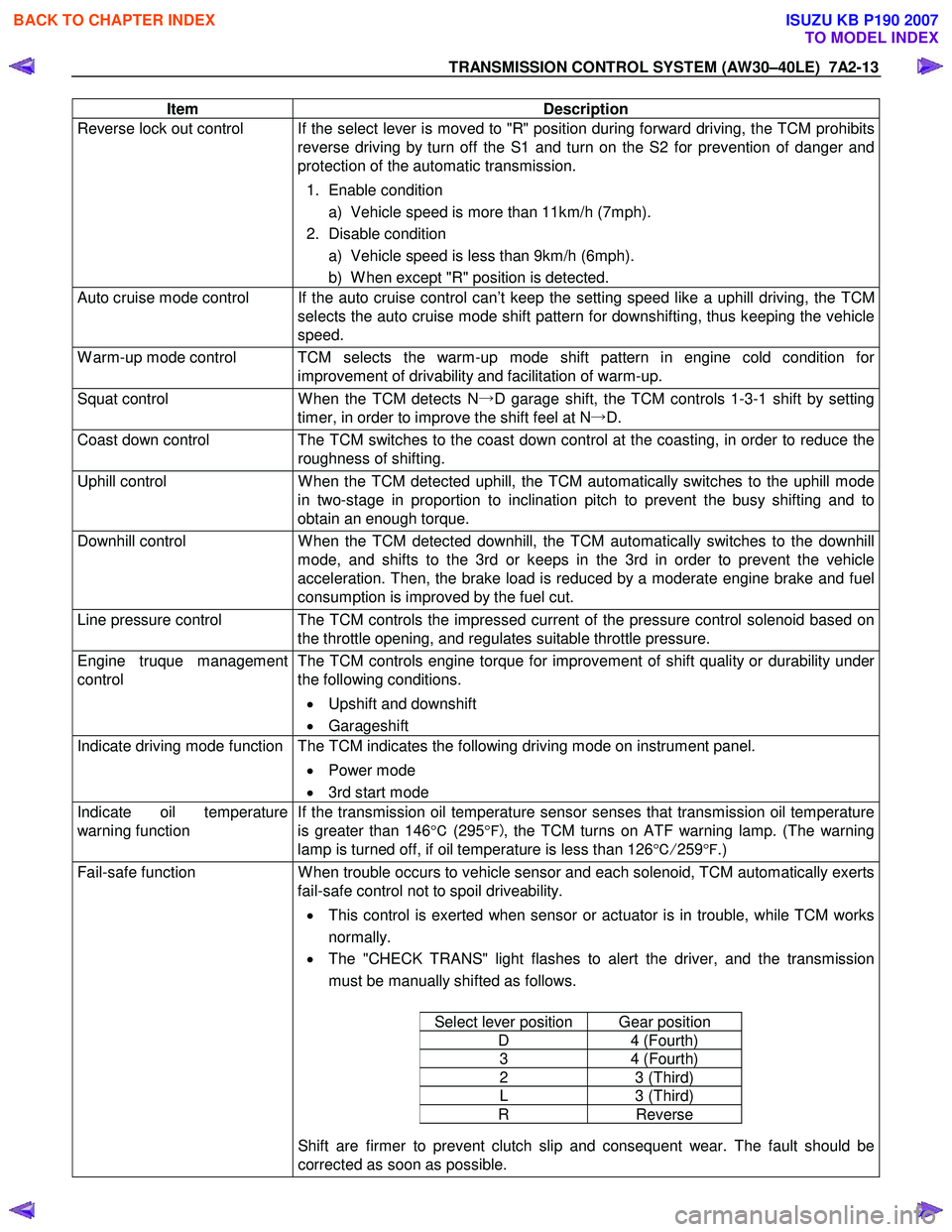
TRANSMISSION CONTROL SYSTEM (AW30–40LE) 7A2-13
Item Description
Reverse lock out control If the select lever is moved to "R" position during forward driving, the TCM prohibits
reverse driving by turn off the S1 and turn on the S2 for prevention of danger and
protection of the automatic transmission.
1. Enable condition a) Vehicle speed is more than 11km/h (7mph).
2. Disable condition a) Vehicle speed is less than 9km/h (6mph).
b) W hen except "R" position is detected.
Auto cruise mode control If the auto cruise control can’t keep the setting speed like a uphill driving, the TCM selects the auto cruise mode shift pattern for downshifting, thus keeping the vehicle
speed.
W arm-up mode control TCM selects the warm-up mode shift pattern in engine cold condition for improvement of drivability and facilitation of warm-up.
Squat control W hen the TCM detects N→D garage shift, the TCM controls 1-3-1 shift by setting
timer, in order to improve the shift feel at N →D.
Coast down control The TCM switches to the coast down control at the coasting, in order to reduce the
roughness of shifting.
Uphill control W hen the TCM detected uphill, the TCM automatically switches to the uphill mode
in two-stage in proportion to inclination pitch to prevent the busy shifting and to
obtain an enough torque.
Downhill control W hen the TCM detected downhill, the TCM automatically switches to the downhill
mode, and shifts to the 3rd or keeps in the 3rd in order to prevent the vehicle
acceleration. Then, the brake load is reduced by a moderate engine brake and fuel
consumption is improved by the fuel cut.
Line pressure control The TCM controls the impressed current of the pressure control solenoid based on the throttle opening, and regulates suitable throttle pressure.
Engine truque management
control The TCM controls engine torque for improvement of shift quality or durability under
the following conditions.
• Upshift and downshift
• Garageshift
Indicate driving mode function The TCM indicates the following driving mode on instrument panel.
• Power mode
• 3rd start mode
Indicate oil temperature
warning function If the transmission oil temperature sensor senses that transmission oil temperature
is greater than 146 °C (295 °F) , the TCM turns on ATF warning lamp. (The warning
lamp is turned off, if oil temperature is less than 126 °C/ 259 °F .)
Fail-safe function W hen trouble occurs to vehicle sensor and each solenoid, TCM automatically exerts
fail-safe control not to spoil driveability.
• This control is exerted when sensor or actuator is in trouble, while TCM works
normally.
• The "CHECK TRANS" light flashes to alert the driver, and the transmission
must be manually shifted as follows.
Select lever position Gear position
D 4 (Fourth)
3 4 (Fourth)
2 3 (Third)
L 3 (Third)
R Reverse
Shift are firmer to prevent clutch slip and consequent wear. The fault should be
corrected as soon as possible.
BACK TO CHAPTER INDEX
TO MODEL INDEX
ISUZU KB P190 2007
Page 3988 of 6020
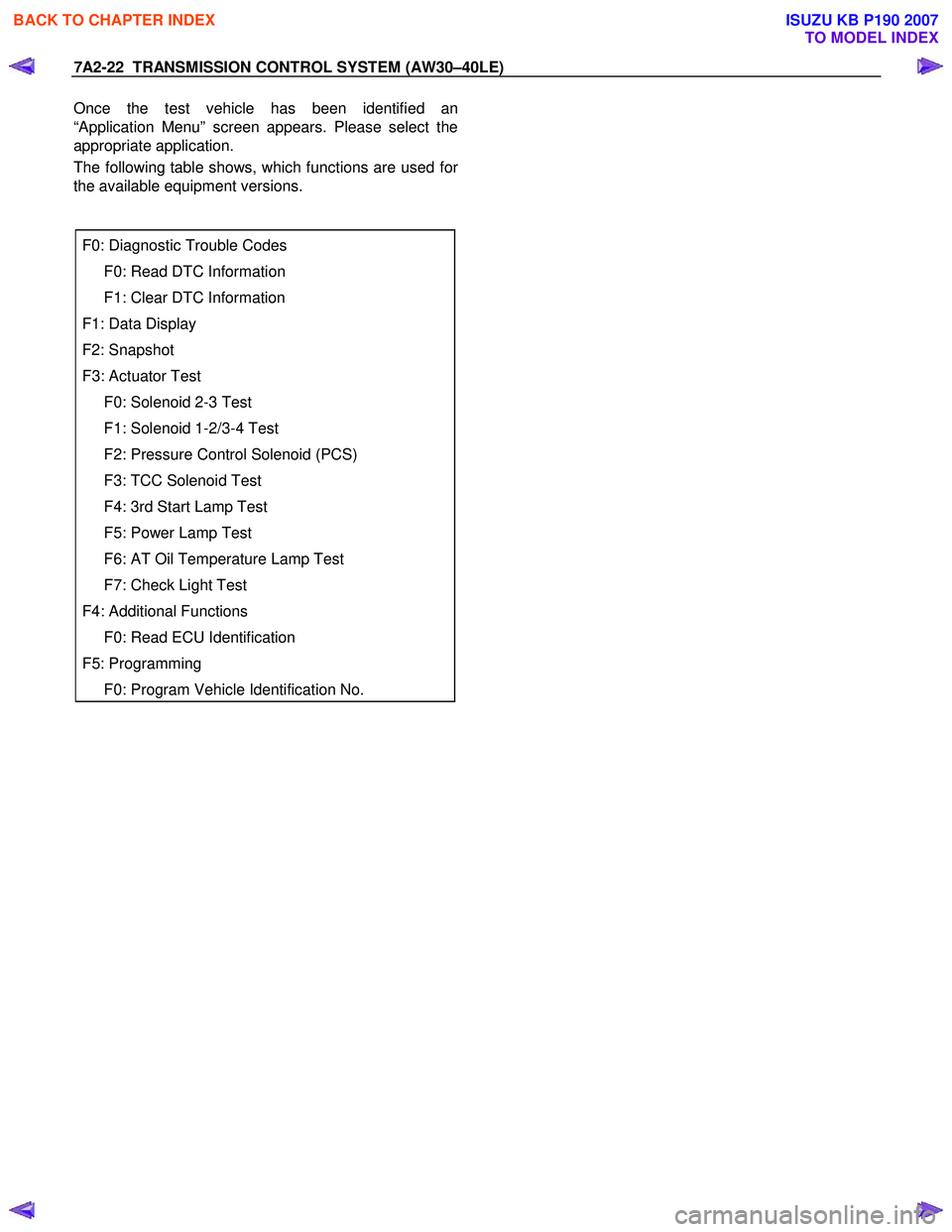
7A2-22 TRANSMISSION CONTROL SYSTEM (AW30–40LE)
Once the test vehicle has been identified an
“Application Menu” screen appears. Please select the
appropriate application.
The following table shows, which functions are used fo
r
the available equipment versions.
F0: Diagnostic Trouble Codes
F0: Read DTC Information
F1: Clear DTC Information
F1: Data Display
F2: Snapshot
F3: Actuator Test
F0: Solenoid 2-3 Test
F1: Solenoid 1-2/3-4 Test
F2: Pressure Control Solenoid (PCS)
F3: TCC Solenoid Test
F4: 3rd Start Lamp Test
F5: Power Lamp Test
F6: AT Oil Temperature Lamp Test
F7: Check Light Test
F4: Additional Functions
F0: Read ECU Identification
F5: Programming
F0: Program Vehicle Identification No.
BACK TO CHAPTER INDEX
TO MODEL INDEX
ISUZU KB P190 2007
Page 3989 of 6020
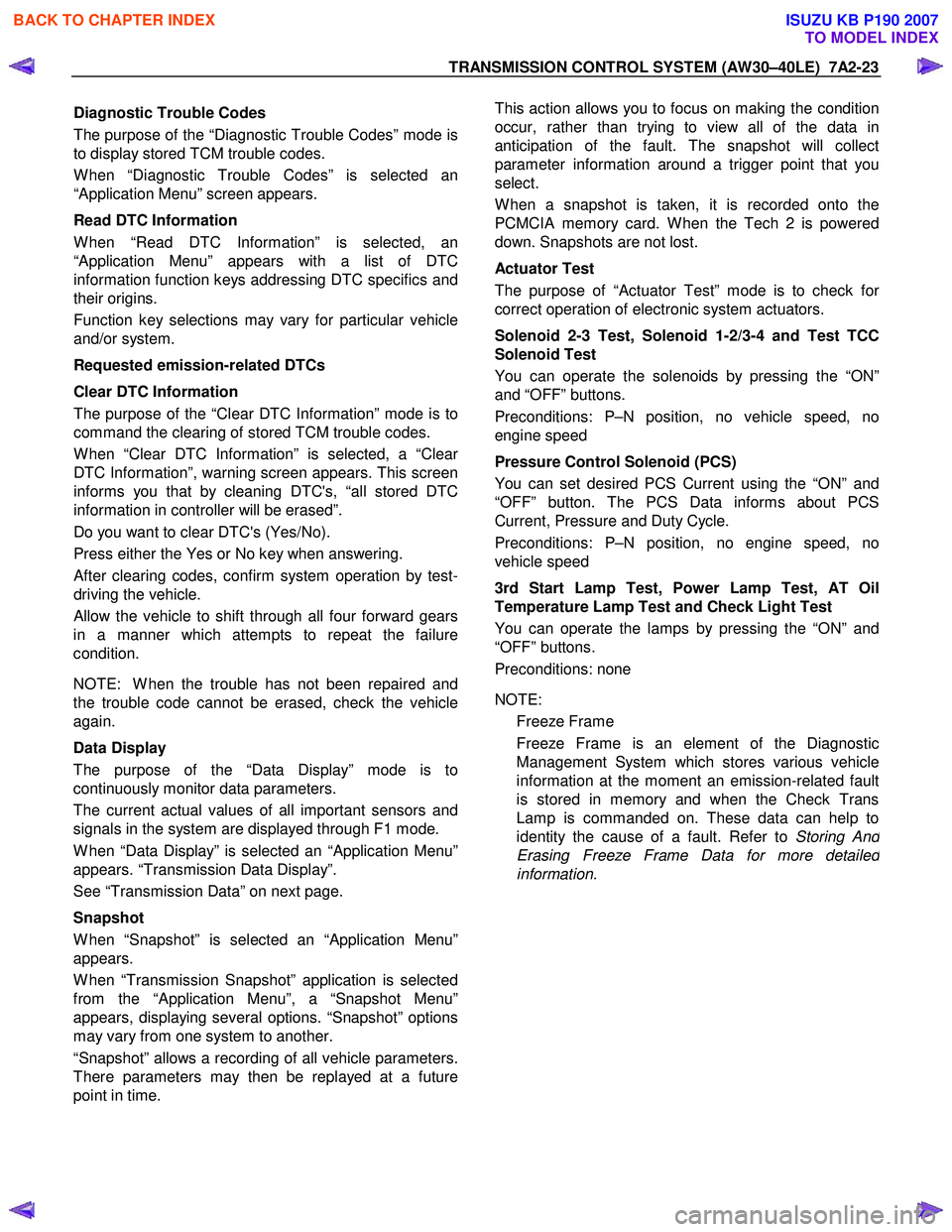
TRANSMISSION CONTROL SYSTEM (AW30–40LE) 7A2-23
Diagnostic Trouble Codes
The purpose of the “Diagnostic Trouble Codes” mode is
to display stored TCM trouble codes.
W hen “Diagnostic Trouble Codes” is selected an
“Application Menu” screen appears.
Read DTC Information
W hen “Read DTC Information” is selected, an
“Application Menu” appears with a list of DTC
information function keys addressing DTC specifics and
their origins.
Function key selections may vary for particular vehicle
and/or system.
Requested emission-related DTCs
Clear DTC Information
The purpose of the “Clear DTC Information” mode is to
command the clearing of stored TCM trouble codes.
W hen “Clear DTC Information” is selected, a “Clea
r
DTC Information”, warning screen appears. This screen
informs you that by cleaning DTC's, “all stored DTC
information in controller will be erased”.
Do you want to clear DTC's (Yes/No).
Press either the Yes or No key when answering.
After clearing codes, confirm system operation by test-
driving the vehicle.
Allow the vehicle to shift through all four forward gears
in a manner which attempts to repeat the failure
condition.
NOTE: W hen the trouble has not been repaired and
the trouble code cannot be erased, check the vehicle
again.
Data Display
The purpose of the “Data Display” mode is to
continuously monitor data parameters.
The current actual values of all important sensors and
signals in the system are displayed through F1 mode.
W hen “Data Display” is selected an “Application Menu”
appears. “Transmission Data Display”.
See “Transmission Data” on next page.
Snapshot
W hen “Snapshot” is selected an “Application Menu”
appears.
W hen “Transmission Snapshot” application is selected
from the “Application Menu”, a “Snapshot Menu”
appears, displaying several options. “Snapshot” options
may vary from one system to another.
“Snapshot” allows a recording of all vehicle parameters.
There parameters may then be replayed at a future
point in time.
This action allows you to focus on making the condition
occur, rather than trying to view all of the data in
anticipation of the fault. The snapshot will collect
parameter information around a trigger point that you
select.
W hen a snapshot is taken, it is recorded onto the
PCMCIA memory card. W hen the Tech 2 is powered
down. Snapshots are not lost.
Actuator Test
The purpose of “Actuator Test” mode is to check fo
r
correct operation of electronic system actuators.
Solenoid 2-3 Test, Solenoid 1-2/3-4 and Test TCC
Solenoid Test
You can operate the solenoids by pressing the “ON”
and “OFF” buttons.
Preconditions: P–N position, no vehicle speed, no
engine speed
Pressure Control Solenoid (PCS)
You can set desired PCS Current using the “ON” and
“OFF” button. The PCS Data informs about PCS
Current, Pressure and Duty Cycle.
Preconditions: P–N position, no engine speed, no
vehicle speed
3rd Start Lamp Test, Power Lamp Test, AT Oil
Temperature Lamp Test and Check Light Test
You can operate the lamps by pressing the “ON” and
“OFF” buttons.
Preconditions: none
NOTE: Freeze Frame
Freeze Frame is an element of the Diagnostic
Management System which stores various vehicle
information at the moment an emission-related fault
is stored in memory and when the Check Trans
Lamp is commanded on. These data can help to
identity the cause of a fault. Refer to Storing An
d
Erasing Freeze Frame Data for more detaile
d
information.
BACK TO CHAPTER INDEX
TO MODEL INDEX
ISUZU KB P190 2007
Page 4004 of 6020
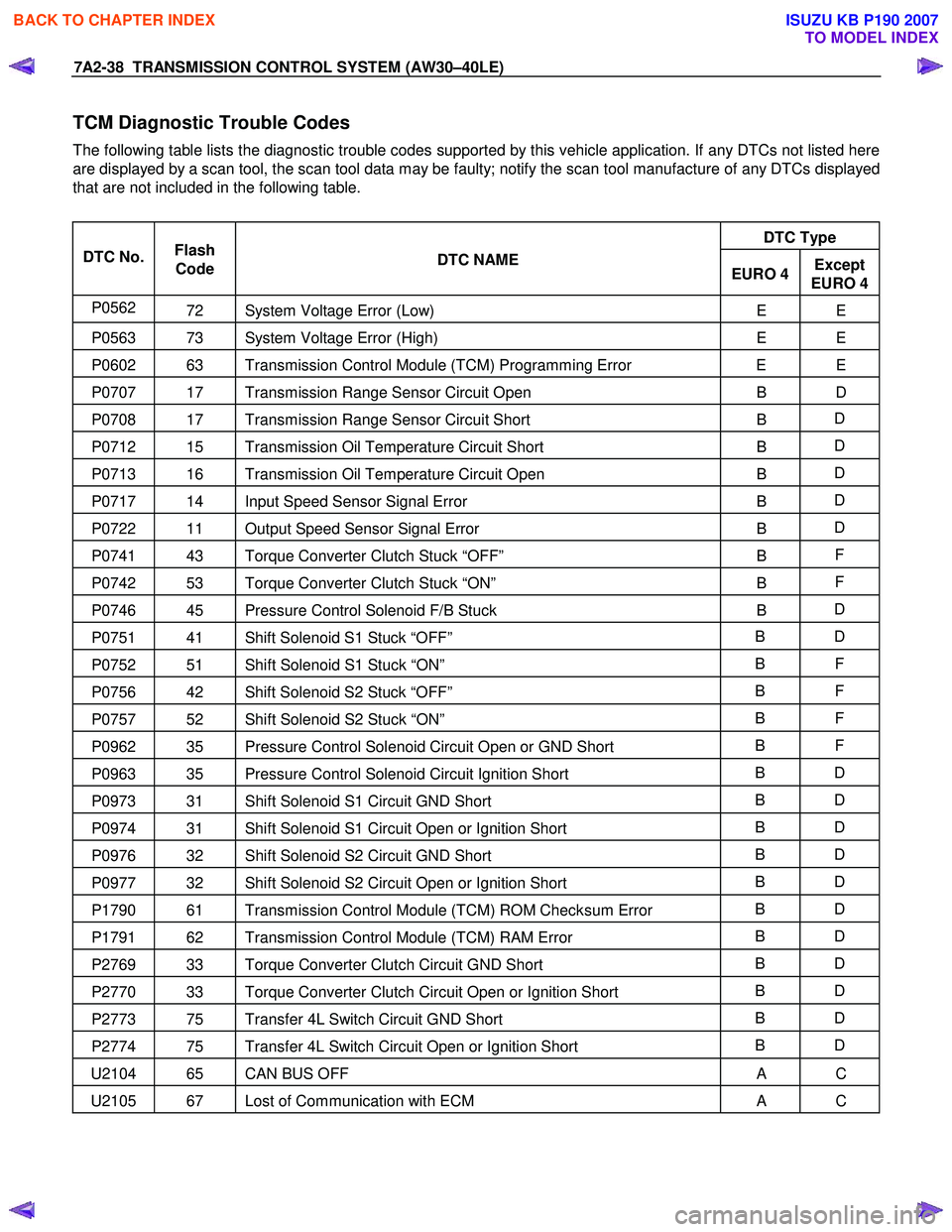
7A2-38 TRANSMISSION CONTROL SYSTEM (AW30–40LE)
TCM Diagnostic Trouble Codes
The following table lists the diagnostic trouble codes supported by this vehicle application. If any DTCs not listed here
are displayed by a scan tool, the scan tool data may be faulty; notify the scan tool manufacture of any DTCs displayed
that are not included in the following table.
DTC Type
DTC No. Flash
Code DTC NAME
EURO 4Except
EURO 4
P0562 72 System Voltage Error (Low) E E
P0563 73 System Voltage Error (High) E E
P0602 63 Transmission Control Module (TCM) Programming Error E E
P0707 17 Transmission Range Sensor Circuit Open B D
P0708 17 Transmission Range Sensor Circuit Short B D
P0712 15 Transmission Oil Temperature Circuit Short
B D
P0713 16 Transmission Oil Temperature Circuit Open
B D
P0717 14 Input Speed Sensor Signal Error
B D
P0722 11 Output Speed Sensor Signal Error
B D
P0741 43 Torque Converter Clutch Stuck “OFF”
B F
P0742 53 Torque Converter Clutch Stuck “ON”
B F
P0746 45 Pressure Control Solenoid F/B Stuck
B D
P0751 41 Shift Solenoid S1 Stuck “OFF” B D
P0752 51 Shift Solenoid S1 Stuck “ON” B F
P0756 42 Shift Solenoid S2 Stuck “OFF” B F
P0757 52 Shift Solenoid S2 Stuck “ON” B F
P0962 35 Pressure Control Solenoid Circuit Open or GND Short B F
P0963 35 Pressure Control Solenoid Circuit Ignition Short B D
P0973 31 Shift Solenoid S1 Circuit GND Short B D
P0974 31 Shift Solenoid S1 Circuit Open or Ignition Short B D
P0976 32 Shift Solenoid S2 Circuit GND Short B D
P0977 32 Shift Solenoid S2 Circuit Open or Ignition Short B D
P1790 61 Transmission Control Module (TCM) ROM Checksum Error B D
P1791 62 Transmission Control Module (TCM) RAM Error B D
P2769 33 Torque Converter Clutch Circuit GND Short B D
P2770 33 Torque Converter Clutch Circuit Open or Ignition Short B D
P2773 75 Transfer 4L Switch Circuit GND Short B D
P2774 75 Transfer 4L Switch Circuit Open or Ignition Short B D
U2104 65 CAN BUS OFF
A C
U2105 67 Lost of Communication with ECM A C
BACK TO CHAPTER INDEX
TO MODEL INDEX
ISUZU KB P190 2007
Page 4018 of 6020

7A2-52 TRANSMISSION CONTROL SYSTEM (AW30–40LE)
DTC P0713 (Flash Code 16)
RTW 77AMF000501
Circuit Description
The oil temperature sensor is a thermistor sensor that is
installed in the transmission case and converts
temperature changes into continuous electric signals,
then outputs them to the Transmission Control Module
(TCM). W hen the ATF temperature is low, the
resistance of the sensor (thermistor) goes up, so that
the voltage of the TCM signal becomes high.
As the ATF is gradually warmed, the resistance of the
sensor goes down and the voltage becomes low. At the
normal operating ATF temperature (80 °C/176 °F) of the
transmission, the voltage of the TCM is about 3.7V.
Condition For Running The DTC
All of the following conditions are met.
(1) Detect the state which the all of the following conditions are met since ignition “ON” fo
r
accumulated 15 minutes or more.
• Except P or N position.
• Selector position switch is not detecting failure or not deciding failure.
• Output revolution is more than 600rpm.
• Output revolution sensor is not detecting failure
or not deciding failure.
(2) Engine coolant temperature ≧ 50 °C (122 °F)
(3) Engine coolant temperature signal is not detecting failure or not deciding failure.
Condition For Setting The DTC
The TCM detects following condition for 12 times
continuously.
• Oil temperature is more than –10 °C (14 °F).
Action Taken When The DTC Sets
• Control at A/T oil temperature 80 °C (176 °F).
• No squat control.
• No slope control.
• No 3rd start mode.
• No line pressure reduction at gear change.
• No coast control.
• No line pressure reduction control at garage.
• No shift solenoid functional failure detection.
BACK TO CHAPTER INDEX
TO MODEL INDEX
ISUZU KB P190 2007
Page 4026 of 6020
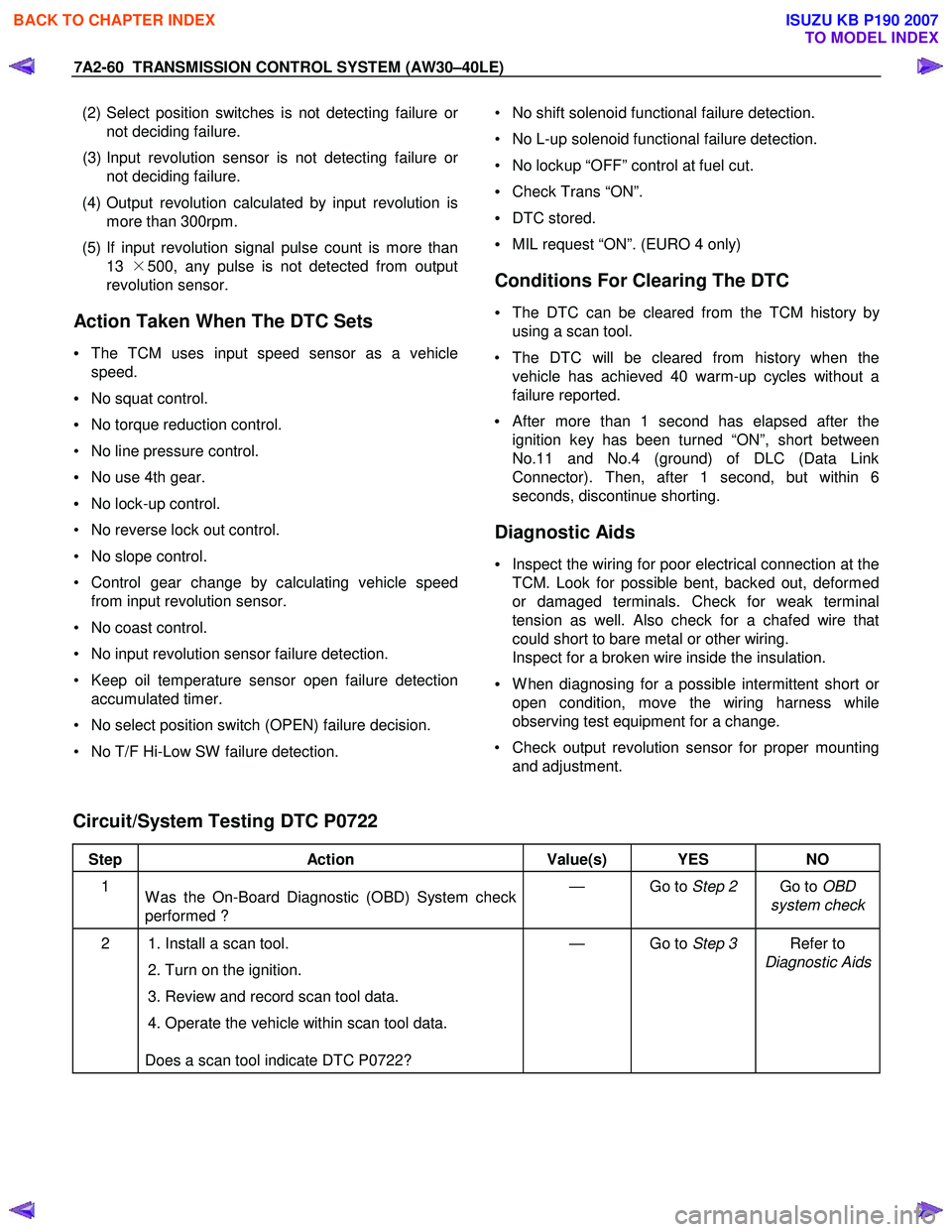
7A2-60 TRANSMISSION CONTROL SYSTEM (AW30–40LE)
(2) Select position switches is not detecting failure o
r
not deciding failure.
(3) Input revolution sensor is not detecting failure o
r
not deciding failure.
(4) Output revolution calculated by input revolution is more than 300rpm.
(5) If input revolution signal pulse count is more than 13 ×500, any pulse is not detected from output
revolution sensor.
Action Taken When The DTC Sets
• The TCM uses input speed sensor as a vehicle
speed.
• No squat control.
• No torque reduction control.
• No line pressure control.
• No use 4th gear.
• No lock-up control.
• No reverse lock out control.
• No slope control.
• Control gear change by calculating vehicle speed from input revolution sensor.
• No coast control.
• No input revolution sensor failure detection.
• Keep oil temperature sensor open failure detection accumulated timer.
• No select position switch (OPEN) failure decision.
• No T/F Hi-Low SW failure detection.
• No shift solenoid functional failure detection.
• No L-up solenoid functional failure detection.
• No lockup “OFF” control at fuel cut.
• Check Trans “ON”.
• DTC stored.
• MIL request “ON”. (EURO 4 only)
Conditions For Clearing The DTC
• The DTC can be cleared from the TCM history by
using a scan tool.
• The DTC will be cleared from history when the vehicle has achieved 40 warm-up cycles without a
failure reported.
•
After more than 1 second has elapsed after the
ignition key has been turned “ON”, short between
No.11 and No.4 (ground) of DLC (Data Link
Connector). Then, after 1 second, but within 6
seconds, discontinue shorting.
Diagnostic Aids
• Inspect the wiring for poor electrical connection at the
TCM. Look for possible bent, backed out, deformed
or damaged terminals. Check for weak terminal
tension as well. Also check for a chafed wire that
could short to bare metal or other wiring.
Inspect for a broken wire inside the insulation.
• W hen diagnosing for a possible intermittent short o
r
open condition, move the wiring harness while
observing test equipment for a change.
• Check output revolution sensor for proper mounting and adjustment.
Circuit/System Testing DTC P0722
Step Action Value(s) YES NO
1
W as the On-Board Diagnostic (OBD) System check
performed ? — Go to
Step 2 Go to OBD
system check
2 1. Install a scan tool.
2. Turn on the ignition.
3. Review and record scan tool data.
4. Operate the vehicle within scan tool data.
Does a scan tool indicate DTC P0722? — Go to
Step 3 Refer to
Diagnostic Aids
BACK TO CHAPTER INDEX
TO MODEL INDEX
ISUZU KB P190 2007
Page 4030 of 6020
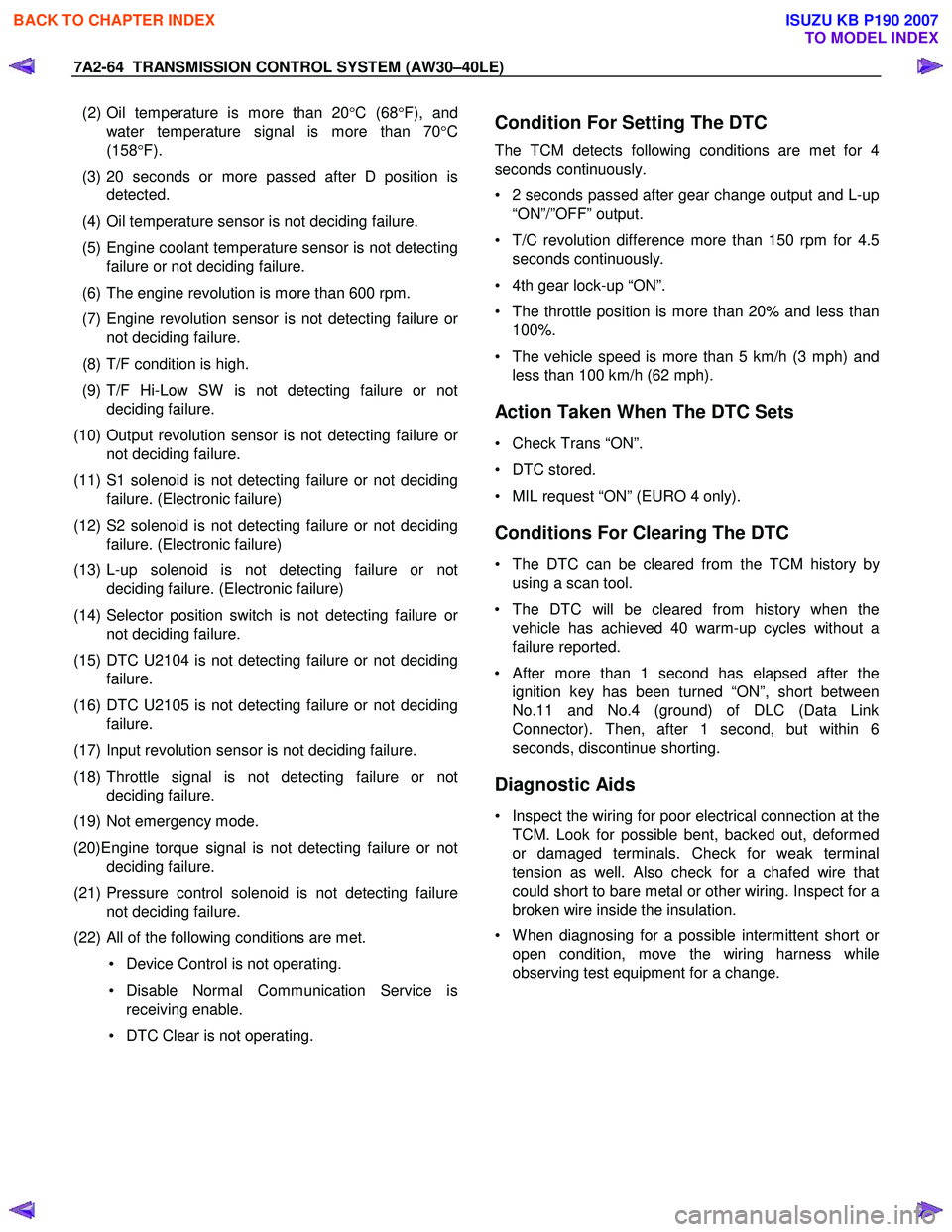
7A2-64 TRANSMISSION CONTROL SYSTEM (AW30–40LE)
(2) Oil temperature is more than 20 °C (68 °F), and
water temperature signal is more than 70 °C
(158 °F).
(3) 20 seconds or more passed after D position is detected.
(4) Oil temperature sensor is not deciding failure.
(5) Engine coolant temperature sensor is not detecting failure or not deciding failure.
(6) The engine revolution is more than 600 rpm.
(7) Engine revolution sensor is not detecting failure o
r
not deciding failure.
(8) T/F condition is high.
(9) T/F Hi-Low SW is not detecting failure or not deciding failure.
(10) Output revolution sensor is not detecting failure o
r
not deciding failure.
(11) S1 solenoid is not detecting failure or not deciding
failure. (Electronic failure)
(12) S2 solenoid is not detecting failure or not deciding
failure. (Electronic failure)
(13) L-up solenoid is not detecting failure or not
deciding failure. (Electronic failure)
(14) Selector position switch is not detecting failure o
r
not deciding failure.
(15) DTC U2104 is not detecting failure or not deciding
failure.
(16) DTC U2105 is not detecting failure or not deciding
failure.
(17) Input revolution sensor is not deciding failure.
(18) Throttle signal is not detecting failure or not
deciding failure.
(19) Not emergency mode.
(20)Engine torque signal is not detecting failure or not deciding failure.
(21) Pressure control solenoid is not detecting failure
not deciding failure.
(22) All of the following conditions are met.
• Device Control is not operating.
• Disable Normal Communication Service is receiving enable.
• DTC Clear is not operating.
Condition For Setting The DTC
The TCM detects following conditions are met for 4
seconds continuously.
• 2 seconds passed after gear change output and L-up “ON”/”OFF” output.
• T/C revolution difference more than 150 rpm for 4.5 seconds continuously.
• 4th gear lock-up “ON”.
• The throttle position is more than 20% and less than 100%.
• The vehicle speed is more than 5 km/h (3 mph) and less than 100 km/h (62 mph).
Action Taken When The DTC Sets
• Check Trans “ON”.
• DTC stored.
• MIL request “ON” (EURO 4 only).
Conditions For Clearing The DTC
• The DTC can be cleared from the TCM history by
using a scan tool.
• The DTC will be cleared from history when the vehicle has achieved 40 warm-up cycles without a
failure reported.
• After more than 1 second has elapsed after the ignition key has been turned “ON”, short between
No.11 and No.4 (ground) of DLC (Data Link
Connector). Then, after 1 second, but within 6
seconds, discontinue shorting.
Diagnostic Aids
• Inspect the wiring for poor electrical connection at the TCM. Look for possible bent, backed out, deformed
or damaged terminals. Check for weak terminal
tension as well. Also check for a chafed wire that
could short to bare metal or other wiring. Inspect for a
broken wire inside the insulation.
• W hen diagnosing for a possible intermittent short o
r
open condition, move the wiring harness while
observing test equipment for a change.
BACK TO CHAPTER INDEX
TO MODEL INDEX
ISUZU KB P190 2007